This essay is an account of Remote Feelings, a collaborative art project conceived of by the authors in 2016. Shaped by sensory difference, remote location and the use of digital technology, namely 3D scanning and printing technology, this project, like this essay, explores haptic experience, the pairing of analogue and digital methods, and the work and influence of Austrian artist and innovator Raoul Hausmann (1886-1971). The essay also shares information on our individual artistic practices and preoccupations, including Florian Grond's use of digital information as a starting point for the exploration of sensory experience and David Johnson's use of his blindness to inform his search for a new aesthetics.
In this essay, we, the authors, David Johnson, an artist and blind person who lives in the United Kingdom, and Florian Grond, an artist and sighted person who lives in Canada, reflect on Remote Feelings, our recent collaboration. We begin by sharing information about our process and follow with reflections on our solo artistic practices and our influences, including the work of Raoul Hausmann. We conclude by sharing our thoughts on the potential of blindness, distance, and digital tools to challenge traditional understandings of visual disability and artmaking.
Our Project and our Process
We first met at the Blind Creations conference in 2015 where we independently exhibited accessible, multisensory works of art. Our plans to collaborate took shape during a conversation at a two-day exhibition of David's work curated by Florian at Concordia University in Montreal in 2016, entitled sculptures from the inner space, please do touch! We started our work together in the spirit of experimentation. All that we were sure about was that we wanted to try to use blindness, remote location, and digital technology as raw materials in a creative and collaborative art enterprise.
We decided that a long-distance collaborative art project between a blind person and a sighted person should not be limited by the use of screen-dependant digital technology. We wondered, if digital 3D modelling and printing technology might offer an appropriate and interesting creative environment for our experiment. We decided to pass a created physical or digital art object, back and forth between David in Hertfordshire, UK and Florian in Montreal, Canada. At each iteration, we would alter or manipulate the object with as little consultation with the other collaborator as possible. We would alternate between analogue and digital forms in order to explore questions about sensory experience and the ontology of the piece we were working on.
We decided to start with a very simple sculptural form: an origami crane. The crane is a traditional icon in Japanese art. Its stylised form, manifested in paper, alludes to ideas of sensory experience and abstraction. Florian started by making about a dozen origami cranes, creating two different styles of cranes out of two different weights of paper. Although origami birds have a strong visual impact, the process of paper folding is a very tactile one and the different papers used to make the birds enhanced their textural qualities. These cranes were sent by mail from Montreal to David in Hertfordshire.
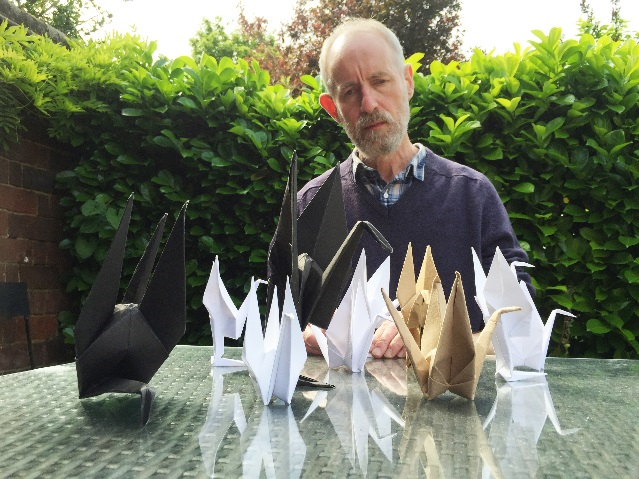
Fig. 1. This photograph shows David sitting outdoors at a table. Behind him is a green hedge; in front of him, on the table, is a grouping of about a dozen paper cranes.
David's plan was to dip the cranes in a silicone solution to improve their structural rigidity then to augment the paper cranes with clay. David adorned various birds with clay 'snakes' in an attempt to both obscure and exaggerate their original shape. These augmented cranes were then sprayed with black paint to yield both visual and textural homogeneity. After 3D scanning some of the altered birds, David selected one and sent the digital file by e-mail to Florian.
Working on the 3D digital files posed an interesting artistic challenge for Florian as he worked with the files digitally on screen. He had to remind himself that any alterations he made would have to be interesting to the sense of touch and not only or necessarily to the sense of sight. Imagining how birds might perceive the world through their wings, as a kind of touch, and connecting this idea with the figure of speech of a birds-eye view, he decided to cut two eyes into the wings of a scan of a sitting bird he had received from David. This symbolic gesture figured sight as absence rather than as presence, as a void which nonetheless occupies a sensory place on the bird's body. This file was returned to David who used 3D printing to create a tactile version of it. David recalls his exploration of the first interim print as an exciting moment. The final print was remarkably detailed, smaller than the original and, of course, made of a very different material to the original. The process was an engaging sensory and intellectual experience.
In migrating between Canada and UK, our simple birds had migrated through a complex set of different materials, forms and even existential states. Layers of paper, silicone, clay and paint had dramatically altered the weight, density and texture of the original birds. Translating the paper-based bird into digital form and then 3D printing the altered algorithms profoundly changed the tactile impact of the resulting sculpture. They were now a homogenous, lightweight, hollow plastic. The differences between the two analogue states were not, in our view, a difference of aesthetic value but more of a change in what we might term their aesthetic personality.
David continued to work with clay and other origami birds from the set. He experimented with various shapes that he felt are reminiscent of how, as a blind person, he explores forms and objects through touch. The result of his work was a set of three arched finger-like forms made of plasticine. We decided to 3D scan and print these sculptures. The printed 3D versions strongly suggested to Florian how David might have explored by touch the origami birds. These finger-like forms became an important addition to the project because of their expression of the central role of the sense of touch in our creation and experience of art objects; we also felt that this trio of finger-like forms expressed something fundamental about our collaboration: they have minute and clear details and, at the same time, they reach into the distant unknown. In the course of our collaboration, we noticed that minute details of our evolving sculpture, resembling nerves or blood vessels, evoked for us the moment of a touch sensation, the firing, for example, of nerves when an object is explored by hand.
Our Solo Practices
While the process of passing the modified object between us gave us the opportunity to think about distance, sensory experience and digitization in new ways, we also appreciate that this project has important continuities with our solo art work and objects we have independently created in the past. We would like to share some information about our solo practices and some of the interests we brought to our work together.
David Johnson: My artwork is first and foremost a response to a powerful urge to make things; this is coupled with a strong desire to express and communicate notions of beauty. These base impulses or motivations have, I believe, developed a potency and personality as a direct result of blindness. To a great extent what I do is no different to what any other creative artist does; at the same time, it is different in specific ways as a result of my being blind.
My preoccupations as an artist are informed by blindness and blind experience; I am keen for others to experience the art I make in a range of ways that include but are not dominated by the visual. I regard blindness as a positive and integral part of the creation of my art and not as something to be 'overcome' or worked around as a barrier to creativity. The pieces I make usually start with an abstract idea. I then imagine the piece in a vivid visual context. The process of creation that follows, the materials I use, and the almost inevitable collaborative element in my process, often mean that the final outcome of pieces I make radically differ from their original conceptions.
My work includes casts, ready-mades, concept pieces and sound artworks. Much of my artwork explores ideas of emergence, ambiguity, the coincidence of absence and presence and, linked to this last, the time-honored epistemological exploration of the relationship between perception and knowledge. These themes and questions are central to everyone's life experience and yet, I argue, are magnified and more immediately accessible in my day-to-day life as a blind person. While I make some very large outdoor pieces, I discuss and share images here of smaller, table-top pieces that are representative of the blind-centred, thematic preoccupations mentioned above. 1
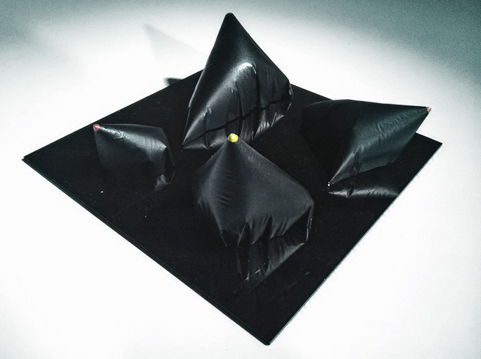
Fig. 2. David Johnson. Citrus Corners. 2012. This photograph shows four plaster casts standing on a highly reflective black Perspex base. They are irregular cone shapes of varying sizes. They are painted black and the very tip of each cone is painted a bright citrus colour.
The first of three pieces I would like to share is titled Citrus Corners. It is a set of small plaster casts grouped on Perspex that suggests something real and present below the surface but beyond our sensory perception. What we can see or feel of these pieces are the tips of something much larger that lies beneath the highly reflective surface, a configuration not dissimilar to volcanic islands or icebergs. The surfaces of these objects bulge and crease as if there is some inner force pushing outwards; this lends these objects a contradictory sensory coincidence that is simultaneously hard and soft. This piece reflects on the idea that most of the meaning or significance that we give to the world is based on scraps of sensory evidence, evidence which is itself ambiguous. It is my contention that, as a blind person, I routinely work with smaller sets of this sensory evidence than sighted people. As a blind person, I feel that I am more familiar than sighted people with the extrapolating process this piece explores.
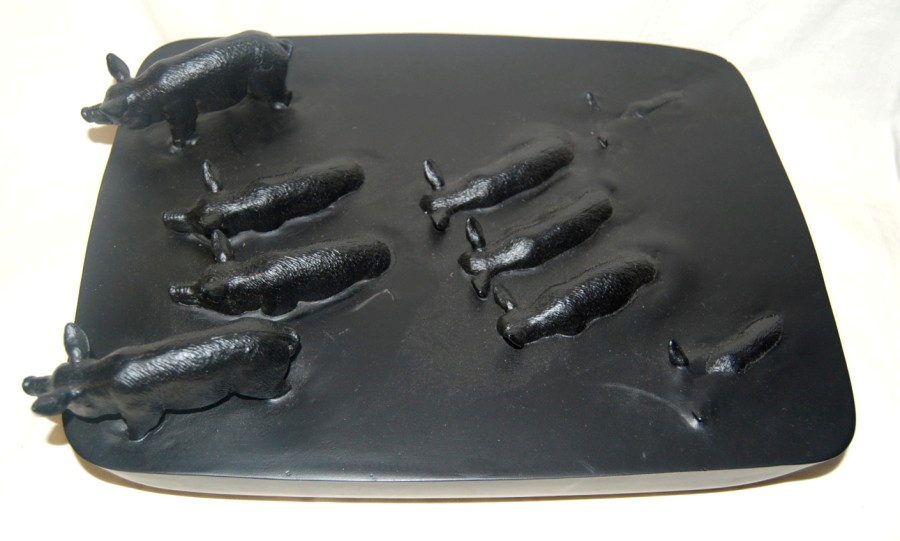
Fig. 3. David Johnson. Black Pigs. 2010. This photograph shows a side view looking from a slightly elevated perspective of nine identical pigs emerging from a rectangular thick plaster base. The pigs are progressively emerging from the base as they move from right to left; the whole piece is painted black.
The second piece of work I would like to share is an arrangement of identical plastic toy pigs set in plaster and painted black. The pigs emerge from an ambiguous surface that could be mud, water or even a cloud. The piece gives the impression of a cohort of real pigs all moving in the same direction on an uncertain but possibly malevolent mission. The fact that the pigs are identical plastic casts from a single factory mould gives them a clone-like, threatening air that is at once fascinating and repugnant. Ambiguity lies at the heart of this piece just as, I would argue, ambiguity and uncertainty lie at the heart of everyone's perceived world, although perceptual ambiguity is, in my experience, an exaggerated feature in the daily life of blind people. 2
Another recurring theme of my small sculptural pieces is the recontextualizing of the commonplace. I experiment with placing very familiar objects in new and unexpected contexts to give them new significance. This too is an idea not unique to blind people and yet it might perhaps be more easily accessed if one is blind. In my work, I explore the idea that a blind person can more easily disassociate themselves from the 'normal' significance of a sound, a smell or indeed an object because their connection with the abstract idea of a thing is arguably more immediate. Sighted people perceive a complex sensory environment, one that can be thought of as 'cluttered' by the full range of sensory stimuli available to them. In my art, I explore the idea that sighted people have a rich relationship with sensory phenomena but less well connected to the conceptual. My piece, Time Lapse, explores this possibility. It consists of coffee spoons set in a series of ordinary disposable coffee cups cast in concrete. The coffee in the cups is at varying levels, suggesting a process of emptying and/or refilling over time. The cups have been removed and each coffee spoon sits in the cast at exactly the same angle, an arrangement that suggests that each cast is a different version of the same cup of coffee as it is emptied or filled, as in a time-lapse film.
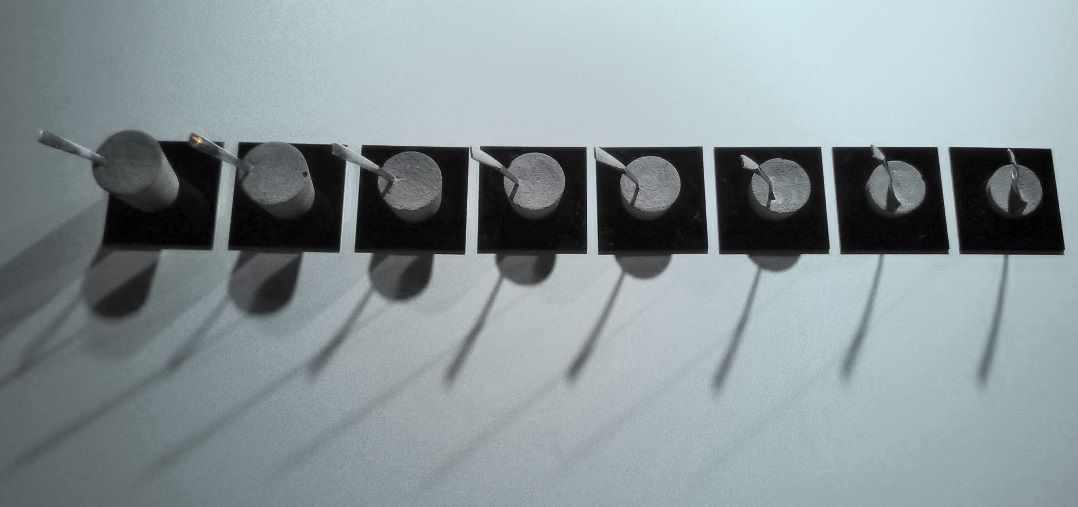
Fig. 4. David Johnson. Time Lapse. 2015 This photograph shows eight concrete casts of coffee beakers standing in a line. They reduce in size from left to right. Each cast has a silver coffee spoon identically angled to the left and each cast stands on its own small square of black Perspex.
Florian Grond: I came to my artistic practice through my scientific research on non-linear dynamical systems. As a scientist, I was initially interested in translating complex data structures into forms and shapes perceptible to humans. I was, and still, am convinced that we understand the complexity of the world that surrounds us better if we find engaging ways to represent it. I started out with computer visualizations, subconsciously following the ocularcentric commonplace that 'seeing is believing.' 3 Very quickly however, I began to explore questions about the validity of particular ways of representing digital data. Although I knew that the dynamical systems I was playing with and attempting to represent visually had no shape and form in and of themselves, and that any shape or colour I gave them was at best notional, I never doubted their existence.
It was later, by reading the work of blind sociologist Siegfried Saerberg, that I became interested in the link between disability and the senses. Saerberg's article "The Sensorification of the Invisible Science, Blindness and the Life-World," in which he links sensory and scientific practices was especially useful for rethinking my creative work. Saerberg's blindness gave his use of the term 'invisible' added interest for me since it described even the unknown in visual terms. At the time I encountered Saerberg's work, I had already moved to sonifying data as an alternative means of data representation to visualization. But the concept of the sensorification of the invisible prompted me to think about the strong link between sensory disabilities, in particular blindness, and a research mindset. An ableist approach to research and artmaking, often manifesting itself in the creation of overwhelming multimedia creations, started to feel like an evasion of the complexity that I had set out to understand.
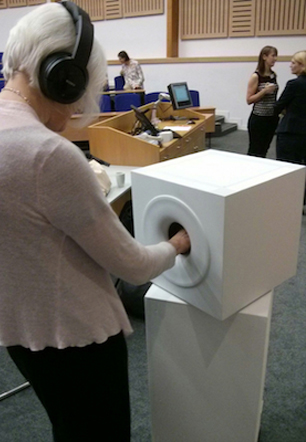
Fig. 5. The Haptophone. This photo shows The Haptophone as it is being explored by a delegate of the Blind Creations conference from the left. The Haptophone consists of a rotating cube that rests on a pedestal of the same size. The cube is slightly twisted with respect to the pedestal. On one face, the cube features an opening, and a delegate reaches a hand in to explore by touch what is heard at the same time over headphones.
At the Blind Creations conference, I had the opportunity to present my sound installation, The Haptophone. The Haptophone attempts to create an experience in which blind and sighted spectators can meet on equal terms by mediating sculptures through both sound and touch. I developed this interactive sound installation in Montreal in consultation with Michael Ciarciello, a musician who is a blind person. In The Haptophone, a three-dimensional sculpture of about fifteen centimetres in height is placed inside a freely rotating pedestal. The sculpture can be touched through an opening but it remains invisible to the sighted spectator. Viewers/listeners wear headphones and are invited to click their fingers close to the miniature sculpture; depending on their position, these clicks generate an echo-like sound, delivered to the viewer/listener by headphones. This sound 'translates' the physical sculpture into a sonic one.
The feedback I received during the presentation of The Haptophone suggested that the close circuiting of listening with touch was an intriguing experience, one that connected the more objectifying distal sense of hearing with the engaging proximity of a touchable object and the pleasure of exploring the world manually. My exploration of a near/far dichotomy was inspired by the work of dada artist Raoul Hausmann, who has been an important figure in the collaboration between David and myself and whose influence we turn to now.
Raoul Hausmann: Re-thinking Sensory Relationships
Exploring the creative potential of disability and technology is, of course, nothing new. The work of Austrian Dada artist and inventor Raoul Hausmann (1886-1971), produced in the early twentieth century, subverted artistic and technological norms in order to reassess conventional thinking about sensorial relationships. Hausmann's era was marked by a general interest in new technologies and in new means of capturing and reproducing cinematic records of audiovisual content. Inspired by these general trends and by witnessing the many veterans returning home from the First World War with disabilities, Hausmann took an active interest in sensory substitution. He was amongst the first to hold a patent in the 1930s for the Optophone, a device created to translate visual information into sound using a mechanical system and sensitive light sensors, the changing voltages of the latter being used to generate sounds via a system of oscillators and filters. Although limited by its poor resolution and low precision, his efforts are significant for our work in large part because rather than being an assistive technology, Hausmann conceived the Optophone "as a scientific and/or artistic instrument that transformed light into sound and vice versa. The instrument was to enable the materialisation of synaesthesia in the form of a universal symphony of light and sound" (Borck 19).
Hausmann went on to develop a theoretical framework that examined the interrelation of the senses and that complemented his early creations, including the Optophone. In his book La Sensorialité Excentrique, Hausmann also explored the concept of haptic rays. He proposed that all the senses are reducible to the sense of touch and suggested that "our perception sends haptic rays even to the most distant stars, and this sensation comes back to us and writes itself into our retina" (Hausmann 37). In his early works, he employed the most modern technology available to him. In his later reflections, he proposed realigning the relative importance of the haptic and the visual and, in so doing, imagined the closing of the gap between distant objects. Hausmann was, it seems, reaching to the stars, and undertook his work with a compelling poetic and sensorial sensitivity.
Hausmann's work influenced our collaboration on a number of levels. The idea of connecting the senses of sight and touch, as Hausmann does by privileging the latter with the notion of a 'haptic ray,' resonated powerfully with us. We wanted to work on sculptures together and contribute equally to the creative process while remaining thousands of miles apart. We hence opted to explore contemporary media that supported ideas similar to those of Hausmann's haptic rays. In our collaborative project, we used established ocularcentric screen-based computer technology in tandem with more contemporary digital scanning technology, digital sculpting software and 3-D print technology both to transmit and to translate ideas between our distant locations and into a non-visually dependant, haptic format. In this way, our work and our process have connections with Hausmann's thoughts about distance and the sense of touch.
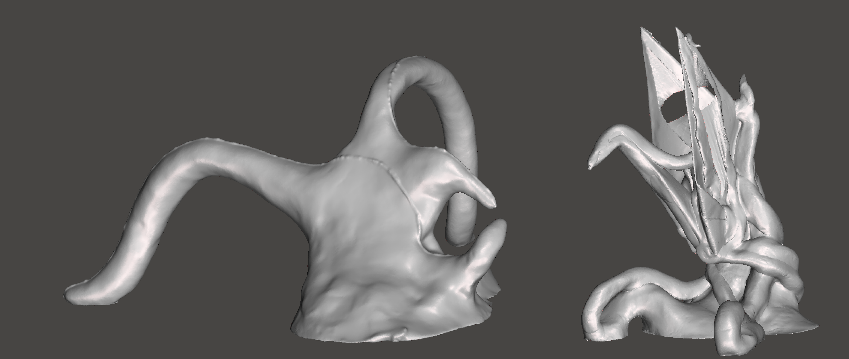
Fig. 6. This black and white digital rendering features two objects from our collaboration: one is the 'reaching fingers' sculptural piece, which features two long finger-like tentacles as well as two smaller digit-like projections positioned in a pinching gesture. The second piece is an altered origami bird. The bird has been layered in places with plasticine, which twines serpent-like around the base of the piece. The wings of the bird each have a section removed from their centre and the head of the bird is directed toward the pinching hand.
Conclusions
Using 3D printing as an assistive technology for long-distance artmaking was not an obvious choice for a collaboration between a blind and a sighted person but it enabled the creative process though, crucially, did not overdetermine it. In our experience, working with conventional analogue material and digital technology together, unexpectedly opened doors at the conceptual level as well as suggesting new and exciting material possibilities and aesthetic standards. In our collaboration, technology combined with influences, such as Hausmann, ended up playing a crucial role in breaking down traditional sensory distinctions. The tactile and the visual became interchangeable, continuous partners in the sensorium. By repeatedly recasting our sculpture between its digital and its analogue forms, we were able to successfully negotiate both our sensory and our geographical differences.
Perhaps the most significant moment in our collaborative art project was the transposition of the paper/clay analogue bird to a 3D print analogue bird via the digital conduit of scanning and 'digital sculpting'. The tactile 'personality' of the two stages of the one piece is marked. The first is multi-layered, dense, weighty and variegated in texture. The second is uniform, light-weight, hollow, and textually homogenous. The 3D print had the effect of 'fusing' or 'blending' the complex elements of the first bird into a unified whole; the form remained unchanged while the material and tactile impact was vastly different. The 3D print formed an integral part of the art production; it was not a copying tool or a reproduction as in photocopying, rather it formed part of the art elements, somewhat like baking a cake fuses the ingredients. The evolutionary, sedimentary accretions that characterized the first bird were 'fast-tracked' into geological homogeneity by the 3D print process.
Importantly, David's blindness and Florian's sightedness prompted us to find new and interesting ways of self-expression by using contemporary technology. By foregrounding tactility, we have explored new possibilities for self-expression for both blind and sighted artists. We think that this project forms the basis of a larger endeavor which will shape our future research and art practice. Chief amongst our findings are:
- The collaborative art project described above suggests how blindness enhances the possibilities of 3D print technology as an art form in itself, at a stage beyond its original function as a prototyping or modeling tool. Similar to how photography quickly became a new form of artistic expression, the 3D print can be developed as an expressive medium with a unique set of aesthetic standards. A 3D print's unique tactile potentialities and access to scale alterations (both of which were illustrated in our project) suggest exciting possibilities for access to artistic expression for visually disabled people.
- Exciting new possibilities for rethinking 'disability', sensory impairment and access to art and artistic expression are suggested by the sensorial reductionism that lies at the heart of our project. Haussman's haptic-rays, which privilege the tactile and undermine the hegemony of the visual, connect with current thinking on modal plasticity and modal cross-talking of the senses and suggest the rich possibilities of by-passing visual input. Art-making methods similar to those used by the project may well be an effective fast-track way to foster new ways of self- and collaborative expression for blind people and for a wider artistic community.
In conclusion, it is our shared belief that the disruptive nature of disability forces artists to consider closely and productively, connections between, for example, the sensory and the societal, the virtual and the material, and the relational and individual autonomy. While our project has produced small-scale sculptures, made to be held in the hand, our collaboration has prompted us to think about German artist Joseph Beuys' idea of the social sculpture (Tisdall), a structure that embodies language, thoughts, actions, and objects in order to shape society. Beuys' social sculpture, in its far-reaching scale, contrasts with the small size of the objects we create in the Remote Feelings project, which are to be explored and understood with all available senses. In addition to providing the immediate pleasure of holding these small-scale sculptures in our audience's hands, we hope we leave impressions in their minds which might lead to reflections on accessibility and cultural participation on a much larger scale. The work produced by our collaboration embodies and expresses our conversations about the difference disability makes to access to the media of artistic production, to collaboration and to dissemination. The experience of any artwork is not limited to an encounter between the audience and an isolated object but always equally involves connections between the artist and society at large. While still ongoing, this project has extended our boundaries as artists and allowed us to work together with the relationship between art, disability, aesthetics and accessibility in mind. We look forward to continuing to push at new doors to explore new sensory relationships, aesthetic standards and ways of working. 4
Works Cited
- Bolt, David. "Aesthetic blindness: Symbolism, realism, and reality." Mosaic: A Journal for the Interdisciplinary Study of Literature, vol. 46, no. 3, Sept. 2013, pp. 93-108. Project Muse, https://doi.org/10.1353/mos.2013.0025
- Borck, Cornelius. "Sound work and visionary prosthetics: artistic experiments in Raoul Hausmann." Papers of Surrealism, vol. 4, no. 1., Winter 2005, pp. 1-25. www.research.manchester.ac.uk/portal/files/63517388/surrealism_issue_4.pdf
- Grond, Florian, et al. The Haptophone. 2015.
- Hausmann, Raoul. La sensorialité excentrique. Editions Allia, 2005.
- Johnson, David. Black Pigs. 2010.
- ---. Citrus Corners. 2012.
- ---. Time Lapse. 2015.
- Saerberg, Siegfried. "The Sensorification of the Invisible Science, Blindness and the Life-world." Science, Technology & Innovation Studies, vol. 7, no. 1, 5 May 2011, pp. 9-28. www.sti-studies.de/ojs/index.php/sti/article/view/51
- Tisdall, Caroline. Art into Society, Society into Art. Institute of Contemporary Arts, 1974.
Notes
-
For a detailed analysis of one of Johnson's outdoor installations, Too Big to Feel, consult the essay by Vanessa Warne in this special issue.
Return to Text -
Johnson's uncertain relationship to the world is explored in more detail by Hannah Thompson in her essay in this special issue.
Return to Text -
As David Bolt observes, "Seeing is believing, according to one epistemological maxim, and this has long since been interpreted to mean that seeing is necessary rather than merely sufficient…. a commonplace confusion between seeing and knowing that is increasingly problematized in our own century" (97).
Return to Text -
The Remote Feelings project is ongoing; in October 2016, we had the opportunity to show first iterations of the project during the exhibition Hands On! at Concordia University in Montreal and in March 2017 the sculptures were part of the show From Inclusion to Partnership at the Institute for Sustainable Education in Jerusalem.
Return to Text


